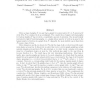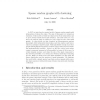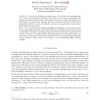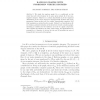SODA
2012
ACM
12 years 10 months ago
2012
ACM
Given a class of graphs F, we say that a graph G is universal for F, or F-universal, if every H ∈ F is contained in G as a subgraph. The construction of sparse universal graphs ...
INFOCOM
2012
IEEE
12 years 10 months ago
2012
IEEE
—This paper focuses on the Internet IP-level routing topology and proposes relevant explanations to its apparent dynamics. We first represent this topology as a power-law random...
100
click to vote
CSR
2011
Springer
13 years 11 months ago
2011
Springer
The Goldreich’s function has n binary inputs and n binary outputs. Every output depends on d inputs and is computed from them by the fixed predicate of arity d. Every Goldreich�...
SIAMDM
2010
14 years 2 months ago
2010
We prove that if T is a tree on n vertices with maximum degree and the edge probability p(n) satisfies: np C max{ log n, n } for some constant > 0, then with high probability...
JCT
2010
14 years 2 months ago
2010
It is well-known that, of all graphs with edge-density p, the random graph G(n, p) contains the smallest density of copies of Kt,t, the complete bipartite graph of size 2t. Since ...
RSA
2011
14 years 2 months ago
2011
: The classical result in the theory of random graphs, proved by Erd˝os and Rényi in 1960, concerns the threshold for the appearance of the giant component in the random graph pr...
RSA
2011
14 years 2 months ago
2011
In 2007 we introduced a general model of sparse random graphs with independence between the edges. The aim of this paper is to present an extension of this model in which the edge...
COMBINATORICA
2010
14 years 4 months ago
2010
Consider the following one-player game. The vertices of a random graph on n vertices are revealed to the player one by one. In each step, also all edges connecting the newly reveal...
ISAAC
2010
Springer
14 years 5 months ago
2010
Springer
We study line systems in metric spaces induced by graphs. A line is a subset of vertices defined by a relation of betweeness. We show that the class of all graphs having exactly k ...
RSA
2010
14 years 5 months ago
2010
We study the random graph Gn,λ/n conditioned on the event that all vertex degrees lie in some given subset S of the nonnegative integers. Subject to a certain hypothesis on S, the...




